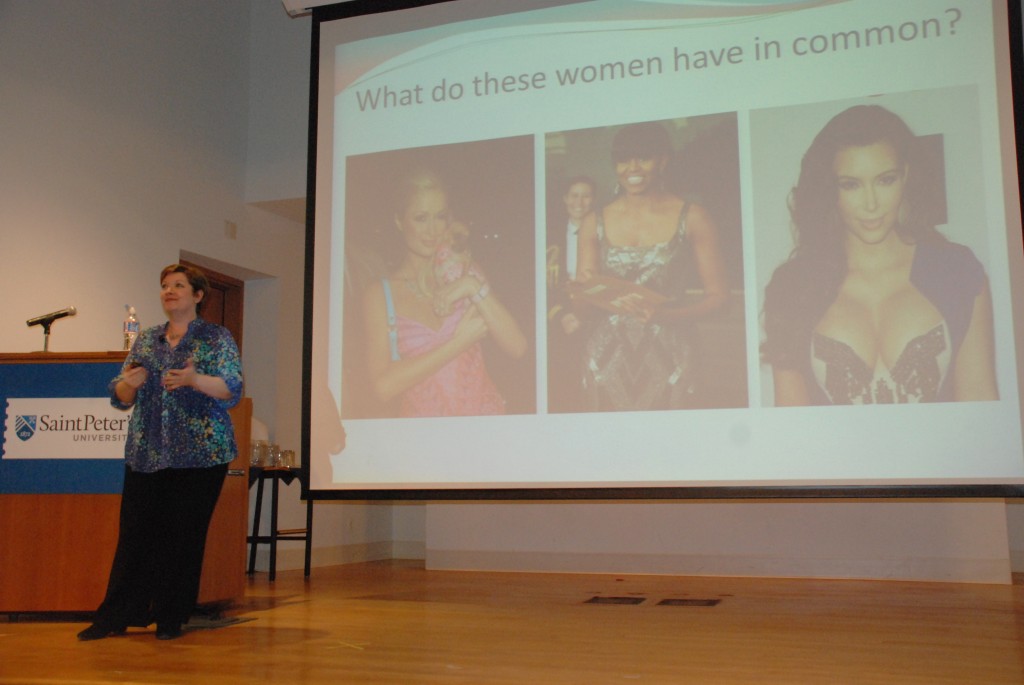American poet Emily Dickinson once wrote, “Celebrity is the chastisement of merit and the punishment of talent.” In today’s media landscape, celebrity news is featured on the front page of print publications, billed as the top story in broadcast news, and fills the newsfeeds of sites such as Facebook and Twitter. The question is: Why is society so fascinated by celebrity stories?
On April 4, “Star Struck: Creating/Covering Celebrity,” the topic of the Sixth Annual Media and History Conference, was held in Pope Lecture Hall to respond to that question.
“The concept of celebrity is so much a part of the cultural environment in which all of us now live because it reflects various components of mass communication, from print to Twitter,” said Eugenia M. Palmegiano, Ph.D., professor emerita of history, who co-organized the event along with representatives from the departments of communication and history, as well as the Theresa and Edward O’Toole Library. “We hope the students will learn to think critically about media notions of celebrity and their presentations of celebrities and will be able to distinguish real importance from hype.”
Lisa M. Burns, Ph.D., from Quinnipiac University opened the discussion with “First Ladies: America’s Earliest Celebrities.”
“What do Kim Kardashian, Michelle Obama and Paris Hilton have in common?” she asked. “They are celebrities. The definition of celebrity is someone who is known for being well known. Because of this, the media and celebrity are intricately linked since the media is one way we get to know people.”
During her lecture, she discussed how the wives of U.S. presidents became known for one of two reasons: their notary as fashion icons or their involvement in political affairs.
“First ladies are arguably among the earliest celebrities because they were the first individuals to become widely known,” she said.
Going as far back as the late 1700s, Dr. Burns used Martha Washington, wife of first president George Washington, as an example of a first lady celebrity due to the continuous newspaper coverage she received about her travels without her husband; publications labeled her as “too queenly.”
Dr. Burns also discussed how many first ladies – such as Mary Todd Lincoln, Mamie Eisenhower and Jacqueline Kennedy – were viewed by the public as fashion icons. While their taste in extravagant clothing created fashion trends among American women of the time, the press often criticized their style for being overpriced and usually imported from Paris.
Political celebrity is another facet of first lady notoriety, and Dr. Burns discussed how women such as Lou Hoover, Eleanor Roosevelt and Hillary Clinton were labeled as advisors to their husbands in the news, and received coverage for being politically active in various organizations.
Following Dr. Burns presentation, a panel discussion, “#FastandFurious on #SocialMedia: From Celebrities to Social Change,” was held with moderator Rev. Rocco C. Danzi, S.J., and panelists Ernabel Demillo, lecturer of communication, and David Surrey, Ph.D., professor of sociology. Later in the afternoon, Professor Meryl Gordon from New York University spoke on “Movie Stars and Politicians: The Pleasures and Perils of the Interview,” followed by the panel discussion “Celebrities: Who Decides?” with moderator Associate Professor of History Jerome Gillen, Ph.D., and panelists history student Laura Reinhart ’14 and communication student Blake Boles ’13.
“I wanted to show students some sense of irony in this topic and successfully argue that big media are the ones that perform the role as gatekeepers and mass media producers. But it’s the paying public –particularly those within the ages of 18-35 with disposable income – who ultimately decide what’s popular,” said Boles.
The History and Media Conference is an annual event at Saint Peter’s University, and topics are selected to coincide with the media landscape of the time. This year’s event was extremely successful, and organizers hope to continue the momentum for next year’s conference.
